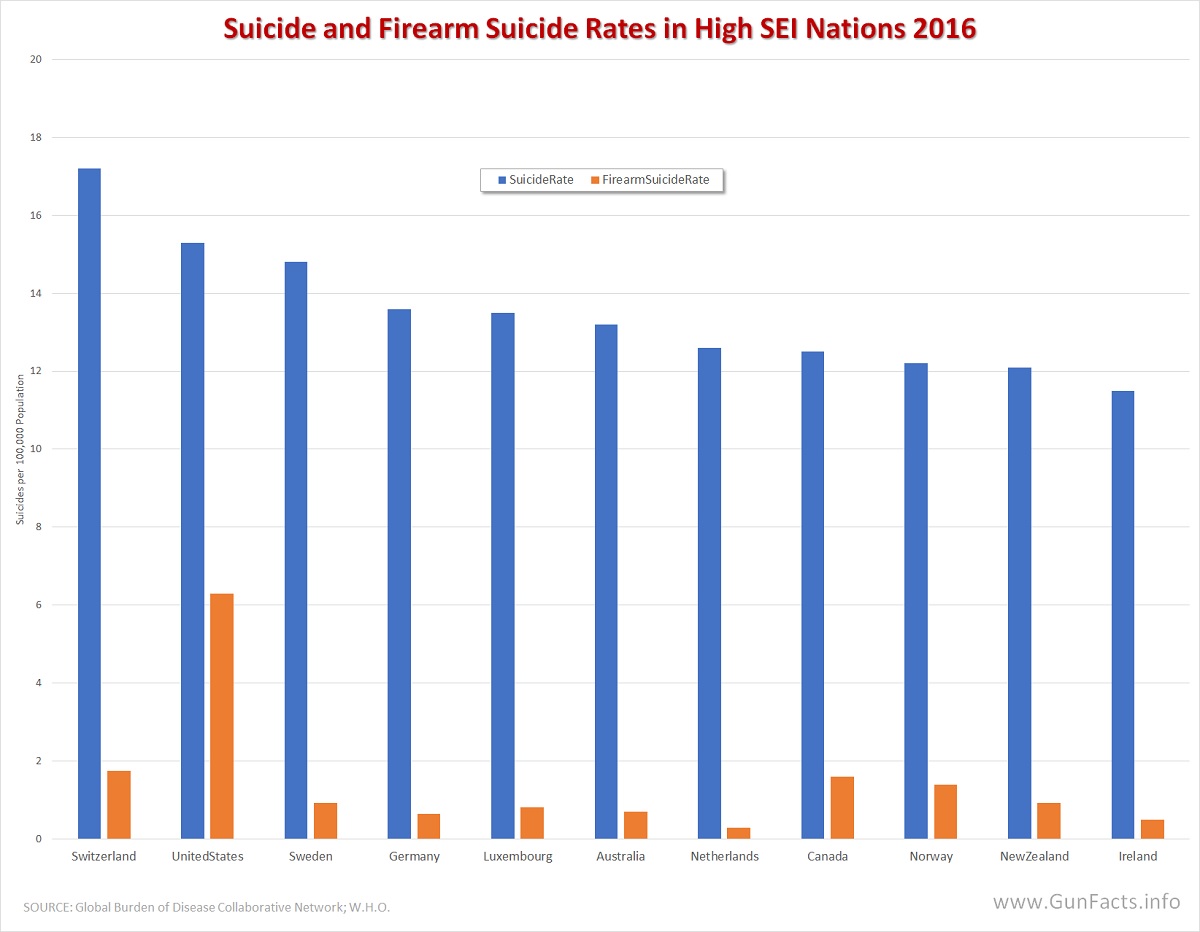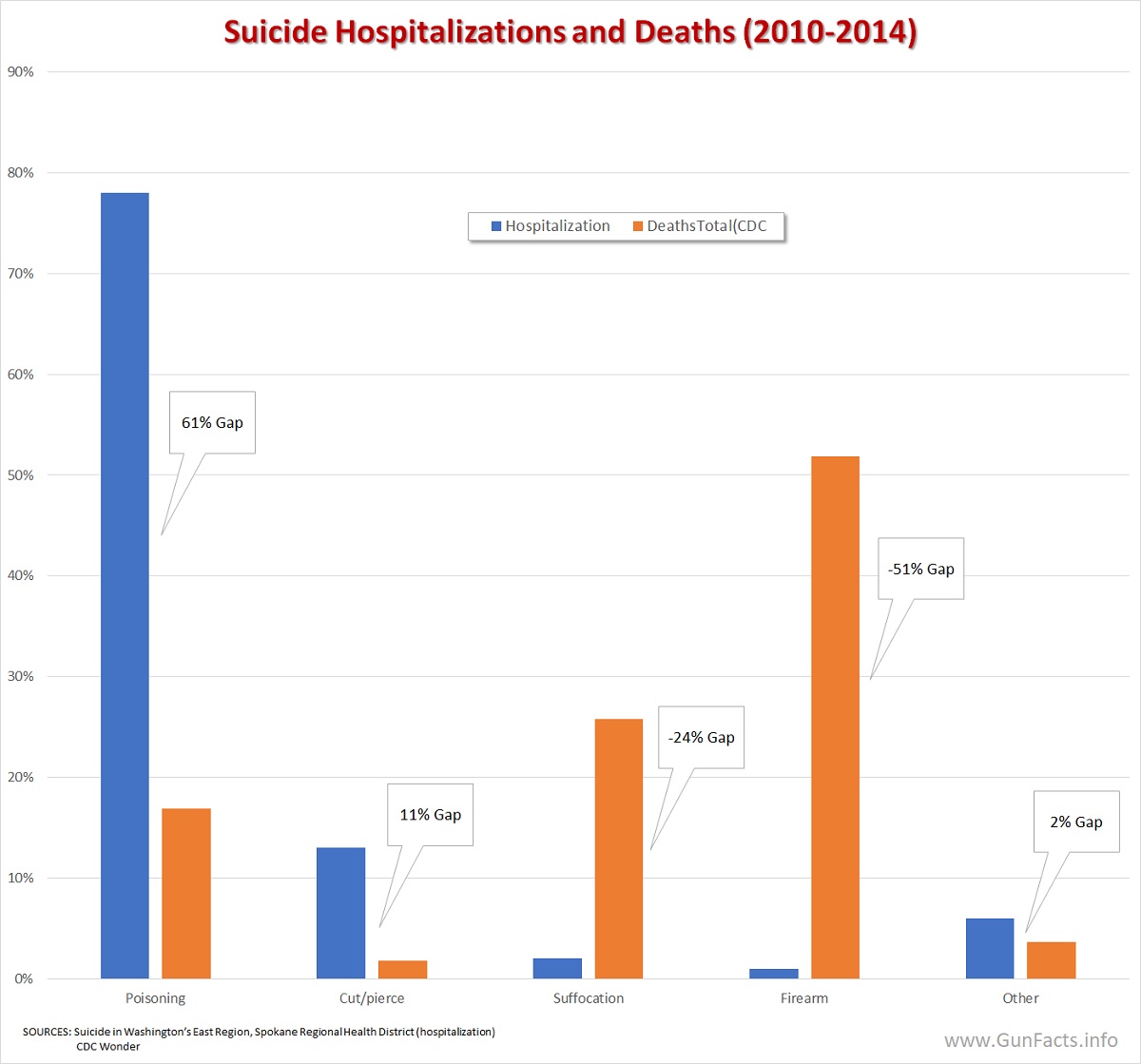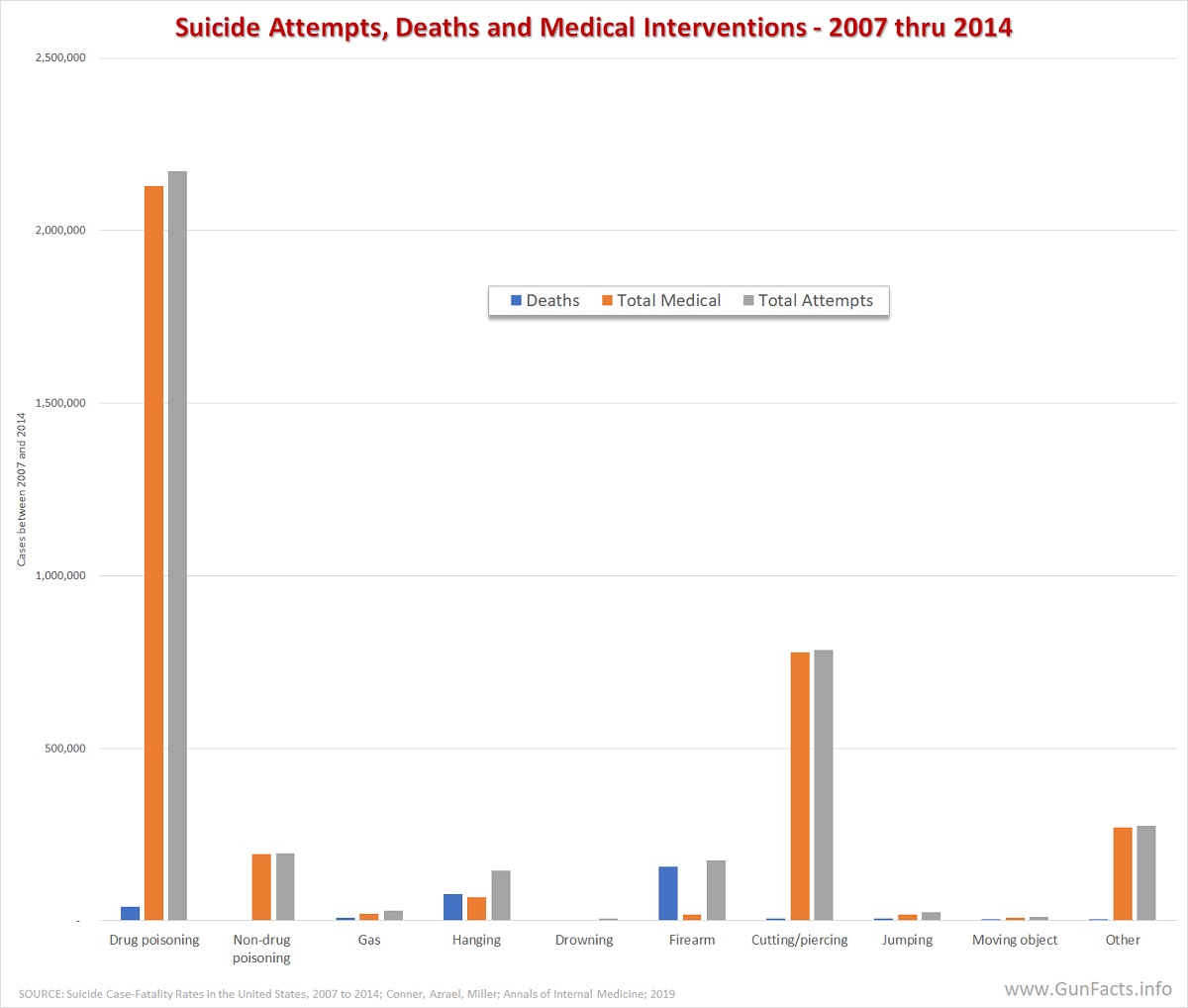Suicide, Survival and Guns
“Guns are inherently more lethal in committing suicides!”
Yet when we looked at W.H.O global suicide data, we discovered that the most suicidal country at the time (Lithuania) had about three times the rate of suicides, 1% as many guns per capita, and nearly everyone killing themselves used rope.
In the USA, where guns are abundant, the data skewed in odds ways. We think we know why, but with a lack of absolute data, it is a little speculative.
The Quick Take-aways
- Suicide “deaths” are those regardless of medical attention.
- Successful suicide victims receive no EMT or hospital treatment.
- EMT/hospitalization is effective for some modes of suicide and not others.
The big clue
We at the Gun Facts project have routinely noted the international disconnect between firearm ownership and suicide rates. In short, the availability of a gun did not affect the probability of a successful suicide.
Looking at just the topmost nations on a socioeconomic index, we see with great clarity that First-World countries have highly similar suicide rates, ranging from 11.5 suicides per 100,000 Irish (death by Guinness overdose does not count) to 17.2 for Swiss (resist the obvious “death by chocolate” jokes). But look at the highly variable firearm suicide rate compared to the comparatively static overall suicide rates. It is clear that in most of the First-World countries, non-gun suicides are just as fatal as gun suicides. Suicide success is assured, but the means vary.
“I’m not dead yet!”
Forgive me for quoting Monty Python while discussing suicide, but in this case, it illustrates the likely data disconnect.
The swing variable is medical care. If the police get a call about someone who has attempted suicide, they arrive and discover either a dead person or a slightly alive person. The fact is some suicidal people are not very good at executing the task (or themselves), or they are discovered before the act is completed (e.g., found before they suffocate in a plastic bag, before the rat poison they ate is fully digested, etc.)
In the former case (dead person), the body is most commonly transported to the county morgue (regardless of the mode of suicide). In the latter case (slightly alive), EMTs provide first aid, the victim is rapidly transported to a hospital, and full medical recovery care is provided. And it is this split that likely causes confusion for some people with agendas to prove.
Timing is everything
The time span between a suicide attempt and death is highly variable. A gunshot wound to the head tends to be instantaneous. Depending on the size of the plastic bag, suffocation can take up to half an hour and recovery is highly likely if the victim is found early. Drugs can take time to kill a body and EMTs have plenty of alternate drugs to reverse the effect if they know what the victim swallowed. Running your car in a closed garage could take an hour (much longer is you have a Tesla). The point is that the fatality of a suicide is highly dependent on (a) whether you are found and (b) how soon help arrives after the attempt, as well as the mode you choose.
Looking at just emergency rooms and hospitals for outcomes is horribly inaccurate (which is why some people do so … because accuracy is not their friend). When some activists claim that “guns are inherently more fatal in suicides”, they cite sources based on emergency room and hospital data and not total death and non-death suicide statistics.
Here is a simple contrast to illustrate (and a caution about mixed data therein). The blue bars show suicide attempts that required hospitalization; by obvious exclusion, they do not include successful suicides where the victim bypassed the ER and went straight to the morgue. The orange bars are the total successful suicide deaths, regardless of whether the victim lived long enough the get treatment or not. The caution on this chart is that since consistent national data is not available, and since the CDC WONDER website makes some things difficult, we are comparing one region in one state with national numbers … not precise, but ballpark accurate.
People who poisoned themselves routinely got hospitalization. Even people who slit their wrists or stabbed themselves saw a doctor in a hospital. But people who use a firearm – which has instantaneous effects – are rarely tended to by a doctor. Stated differently, the odds of suicide survival decrease when the time to death after committing the action decreases.
But the odds of dying from any form of suicide are close to 100% if nobody finds you. Recall that it could take half an hour to suffocate in a plastic bag (the second most popular form of suicide in the USA). In the average home, where people expect to see you frequently pass through on the way to the refrigerator or toilet, the odds of being discovered before death are pretty high. The odds go way down when hearing “bang” is their first clue.
Where the numbers evade us
One source does provide more clarity, but not enough to make the Gun Facts number nuts completely happy.
| Attempts | 1,442,000 | % Of Attempts |
| No treatment | 233,656 | 16% |
| Medical attention | 717,000 | 50% |
| Hospitalized 1+ days | 443,000 | 31% |
| Deaths | 48,344 | 3% |
The Suicide Prevention Resource Center diced CDC numbers we don’t (yet) have access to. In the year 2018, American suicide attempts had the outcomes in the table at right.
A full 50% of people who attempted suicide received medical treatment, and 31% were in the hospital at least overnight. That means 81% of suicide attempts received some form of medical treatment—which, depending on other variables, is more likely than the mode of suicide to be the primary cause of survival.
Now, the sundry caveats:
- Some unknowable percentage of these were “cries for help” and not really suicide attempts.
- Some unknowable percentage of these were people incompetent in killing themselves (for example, I know a young fellow who swallowed a bunch of Tylenol, but not enough to die).
- Some unknowable percentage of these would have survived even without medical attention.
- Some unknowable and very small percentage were attempted homicides that the victim would not disclose.
But let’s run with the numbers a bit more. In the same year, as reported by the same source, 50.5% of successful suicides were by firearm. That divides out to 24,413 firearm suicide deaths, which is 1.7% of all suicide attempts.
The open question remains: “How many people are rescued from suicide by medical treatment?” It is impossible to tell, but ponder this basic contrast:
- 7: Percent of suicide attempts by firearm that result in death
- 4: Percent of suicide attempts that receive medical treatment
- 6: Percent of non-fatal suicide attempts
Clearly, the mode of suicide is far less significant than a response by a medical team to a suicide attempt.
UPDATE #1:
Shortly after performing our review, we happened upon a paper from 2019 1 that was very rigorous, used good data sources, performed no statistical slight of hand and basically confirmed our findings above (all of which is rather surprising given that the study was funded by the Joyce Foundation).
In the chart you will see that nearly no firearm suicide attempts receive medical treatment. You will also notice that firearm suicides only account for 4.6% of all suicide attempts while receiving 0.5% of medical interventions.
In the absence of quick response and constantly improving medical treatments, we might see firearms slide down the suicide fatality scale.
Notes:
- Suicide Case-Fatality Rates in the United States, 2007 to 2014; Conner, Azrael, Miller; Annals of Internal Medicine; 2019 ↩
This article first appeared on Gun Facts. Please make a donation directly to them at https://www.gunfacts.info/donate/









